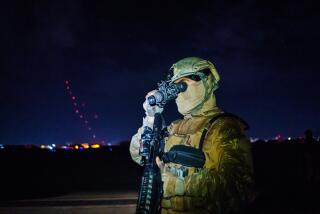PROTECTING THE TROOPS
- Share via
The shooting has stopped in the Gulf War, but U.S. briefers warn that the battlefield continues to be a dangerous place. Apart from the obvious threats of still-armed enemy soldiers and unexploded mines, the desert is a formidable environment. From head-to-toe, the equipment worn by U.S. troops are believed to offer greater protection and comfort than their Vietnam-era precursors: HELMET BACKGROUND: The Army’s new Kevlar helmet was developed by the same man who, in the 1950s, worked on a baseball helmet with earflaps for Little Leaguers. Dr. Creighton Hale, a former professor of physiology, was chairman of the national committee that developed the Army’s new plastic head covering.
DESIGN: Helmet, based on dimensions of the male skull, offers 12% more head cover than its metal forerunner. Among its features: * First worn by U.S. troops during the Grenada invasion of 1983, where it was credited with saving at least two lives. * Two times stronger than the old “steel pot” type. * Weighs about the same as its predecessor, 3.3 pounds. * Design allows for greater air circulation. * Plastic soaks up less heat than the metal version. * Worn with desert or jungle camouflage cloth covers. OF NOTE: * Unlike the steel helmets, the Kevlar model cannot double as a soup pot and wash basin. * First worn by U.S. troops during the Grenada invasion of 1983, where it was credited with saving at least two lives. COST: $100 each BODY ARMOR BACKGROUND: Kevlar fragmentation vests, which look like sleeveless outdoors wear, are standard infantry issue. The body armor protects the upper torso against most bursting munitions, which account for a majority of battlefield casualties. The vests, unlike those worn by police officers, are not designed to provide protection against bullets.
DESIGN: The garments fiber, are greatly improved from the nylon vests worn in Vietnam. Among their features: * Lighter, better vented and more comfortable.
* A size medium vest weighs 9 pounds, thre-fourths the weight of its predecessor. * Covers area from the hip to the neck as well as throat.
* Designed to work in conjunction with the Kevlar helmet. * Worn with replacable cloth desert or jungle camouflage cover. OF NOTE: * Vest stopped AK-47 rounds in Grenada, where it was first worn.
COST: $250 BOOTS BACKGROUND: U.S. troops arrived in the searing heat of the Saudi Arabian desert wearing boots designed for combat in the muddy jungles of Southeast Asia. The polished black leather canvas-topped boots with steel-plated soles quickly soaked up heat and sand, increasing the discomfort level. A concerned Gen. Norman Schwartzkopf personally helped modify the boots. DESIGN: The new boot is designed to be lighter and cooler than its jungle counterpart. Unfortunately, only a limited number of these boots arrived in the Gulf in time. Among the new, sand-colored boot’s features: * Lightweight soles * Ankle-supports * Soft padded “collar” that prevents sand from pouring in at the top. * Speed lace system, allowing wearer to put on boots in about 15 seconds. * Thermal barrier, to insulate foot from desert heat OF NOTE: * The new boot is informally known as the “Schwarzkopf Desert Boot. * Available in 105 sizes COST: $50.00
More to Read
Sign up for Essential California
The most important California stories and recommendations in your inbox every morning.
You may occasionally receive promotional content from the Los Angeles Times.








